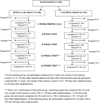Effect of a Binocular iPad Game vs Part-time Patching in Children Aged 5 to 12 Years With Amblyopia: A Randomized Clinical Trial
- PMID: 27812703
- PMCID: PMC5145771
- DOI: 10.1001/jamaophthalmol.2016.4262
Effect of a Binocular iPad Game vs Part-time Patching in Children Aged 5 to 12 Years With Amblyopia: A Randomized Clinical Trial
Abstract
Importance: A binocular approach to treating anisometropic and strabismic amblyopia has recently been advocated. Initial studies have yielded promising results, suggesting that a larger randomized clinical trial is warranted.
Objective: To compare visual acuity (VA) improvement in children with amblyopia treated with a binocular iPad game vs part-time patching.
Design, setting, and participants: A multicenter, noninferiority randomized clinical trial was conducted in community and institutional practices from September 16, 2014, to August 28, 2015. Participants included 385 children aged 5 years to younger than 13 years with amblyopia (20/40 to 20/200, mean 20/63) resulting from strabismus, anisometropia, or both. Participants were randomly assigned to either 16 weeks of a binocular iPad game prescribed for 1 hour a day (190 participants; binocular group) or patching of the fellow eye prescribed for 2 hours a day (195 participants; patching group). Study follow-up visits were scheduled at 4, 8, 12, and 16 weeks. A modified intent-to-treat analysis was performed on participants who completed the 16-week trial.
Interventions: Binocular iPad game or patching of the fellow eye.
Main outcomes and measures: Change in amblyopic-eye VA from baseline to 16 weeks.
Results: Of the 385 participants, 187 were female (48.6%); mean (SD) age was 8.5 (1.9) years. At 16 weeks, mean amblyopic-eye VA improved 1.05 lines (2-sided 95% CI, 0.85-1.24 lines) in the binocular group and 1.35 lines (2-sided 95% CI, 1.17-1.54 lines) in the patching group, with an adjusted treatment group difference of 0.31 lines favoring patching (upper limit of the 1-sided 95% CI, 0.53 lines). This upper limit exceeded the prespecified noninferiority limit of 0.5 lines. Only 39 of the 176 participants (22.2%) randomized to the binocular game and with log file data available performed more than 75% of the prescribed treatment (median, 46%; interquartile range, 20%-72%). In younger participants (aged 5 to <7 years) without prior amblyopia treatment, amblyopic-eye VA improved by a mean (SD) of 2.5 (1.5) lines in the binocular group and 2.8 (0.8) lines in the patching group. Adverse effects (including diplopia) were uncommon and of similar frequency between groups.
Conclusions and relevance: In children aged 5 to younger than 13 years, amblyopic-eye VA improved with binocular game play and with patching, particularly in younger children (age 5 to <7 years) without prior amblyopia treatment. Although the primary noninferiority analysis was indeterminate, a post hoc analysis suggested that VA improvement with this particular binocular iPad treatment was not as good as with 2 hours of prescribed daily patching.
Trial registration: http://www.clinicaltrials.gov Identifier: NCT02200211.
Conflict of interest statement
No conflicting relationships exist for any of the authors.
Figures


Comment in
-
Binocular Treatment of Amblyopia in Children: Teething Problems on the Path to Clinical Practice.JAMA Ophthalmol. 2016 Dec 1;134(12):1400-1401. doi: 10.1001/jamaophthalmol.2016.3657. JAMA Ophthalmol. 2016. PMID: 27812701 No abstract available.
-
New Treatments for Amblyopia-To Patch or Play?JAMA Ophthalmol. 2016 Dec 1;134(12):1408-1410. doi: 10.1001/jamaophthalmol.2016.4296. JAMA Ophthalmol. 2016. PMID: 27832261 No abstract available.
References
-
- Hess RF, Mansouri B, Thompson B. A new binocular approach to the treatment of amblyopia in adults well beyond the critical period of visual development. Restor Neurol Neurosci. 2010;28(6):793–802. - PubMed
-
- Knox PJ, Simmers AJ, Gray LS, Cleary M. An exploratory study: prolonged periods of binocular stimulation can provide an effective treatment for childhood amblyopia. Invest Ophthalmol & Vis Sci. 2012;53(2):817–824. - PubMed
Publication types
MeSH terms
Associated data
Grants and funding
LinkOut - more resources
Full Text Sources
Other Literature Sources
Medical

